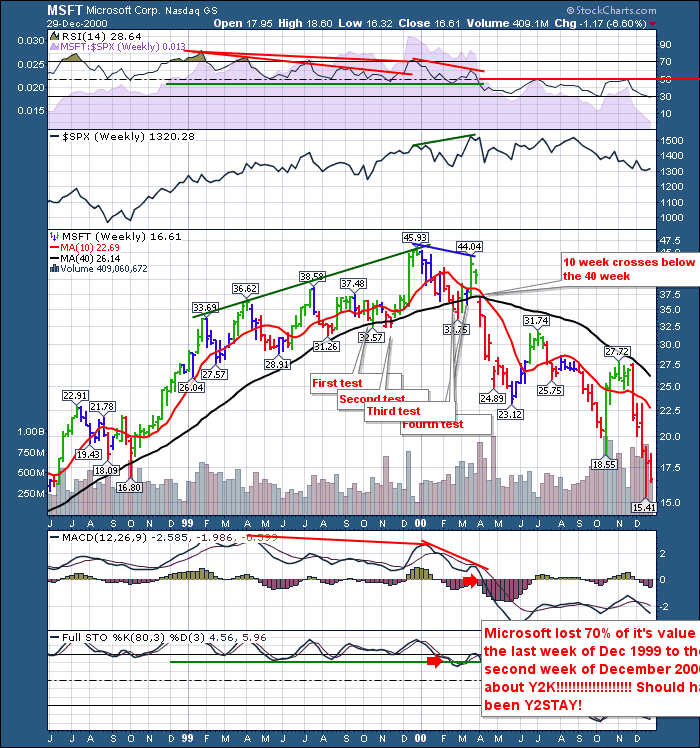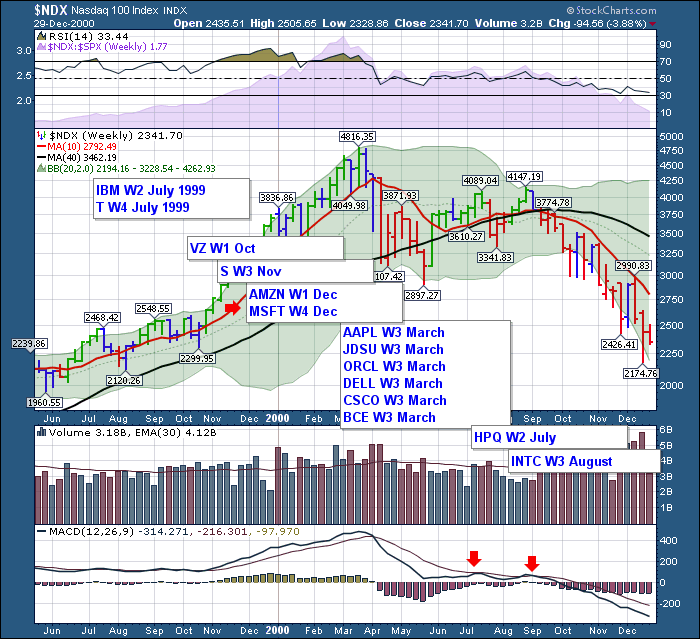I have been watching the tech stocks with great interest over the last few months. Not just as investments, but as to their role in the broader market investment theme.
This blog information won't come as a surprise to the webinar viewers but it will be a long multi part blog that we can continue to use to check the status. All the charts are clickable, so lets start this thesis and continue to review to see how we can add more analytical strength to the concept over the next few months and years. At this point its a compelling story. We must verify the results over time.
First of all, let's start with a link to the webinar that contained some of my thoughts on this subject to bring new readers up to speed on where this is going. The January 23rd, 2013 presentation covered off the main topic of $SPX wedges and I presented this blogs tech concept as part of the presentation. It was probably forgotten while the $SPX was surging to new highs and testing the top of the wedge. Webinar
For those that have not seen the webinar, you may find it interesting in total. However, for those that did see the webinar, at 38:25 minutes in, I discuss the concept of using tech stocks to help identify when we are nearing broader market tops. Today we'll start to go into much greater depth as this was not the main subject of the webinar. As the blog would be too long, I'll break it into multiple parts.
This blog is not written as a hard and fast market rule. It has been derived from my historical review of the market action during the 2000 and 2007 market peaks. While that is a small sample size, I do believe it to be relevant again at this time. I do think it can alert us to watch for more intricate information under the market indexes.
For some history, I was one of the people who bought Apple between Christmas and New Years in December 2007 at just above $200/share. I was buying the strongest stock on a breakout to new highs. Well, within 6 weeks I was down almost 20% on my position and sold. That single sale made me decide to become a technical trader and ignore or minimize the fundamentals of the company.
So this is my thesis of the tech titans.
When the senior tech stock 'unexplicably'(of course there is a reason...) breaks down after being the confirmed leader, something is changing. In general, institutions are behaving differently. Interestingly enough, at both 2000 and 2007, the largest stock in the tech world broke down before the rest of the tech sector. So now that the single largest leading stock, AAPL, has broken down, we want to focus our attention on the rest of the tech titans to watch closely for signs of weakness and non confirmation of market rallies.
Here is the chart of MSFT in 1999.
We have to understand just how bullish the time period was. The Nasdaq was up 90% the year before. Everyone was quitting their day jobs to become daytraders. The Internet stocks were surging every day. MSFT had launched Windows 2000, Office 2000, Sequel Server and Apple Computer had recently (1997) asked MSFT to give them $150M for non-voting shares. MSFT was dominating the world. The profits were going to be huge next year as Apple was almost dead on the computer front.
So lets look at the chart. Let's start on the RSI. First of all, the negative divergence was building all through 1999. But at the end of the year, the price took off like an elevator and the RSI snapped the negative deviation and surged up to 70. The RSI then made a lower high in concert with price. There was really no divergence between the price pattern and the RSI at $45.93 and $44.04. Slightly lower on both.
The purple shaded area in the background compares the $SPx Using the Relative Strength. I call it SPURS and I will use that term for this blog and most blogs I write. You will notice that right up to the peak in MSFT it outperformed the $SPX. It did not slow down prior to this.
Notice the $SPX went on to new highs while MSFT wass literally unloading. It had fallen 25% in 6 weeks while the $SPX was going on to higher highs. It kept trying to find support at the 40 week MA or 40 WMA. When it lost the 40 WMA, you can see it bounced again after having lost 50% of the market cap down to $23.12. A bounce failed and it ultimately made a major low only 11 months after the all time high; losing 2/3rds of the value. A trendline under the $SPX would have told you to exit the market around July or August. However, even if you held some of the absolute greatest companies of the day, your portfolio was already damaged.
The volume pattern was quite remarkable. Look how it stayed quiet all through May, June, July August. No buyers showing up for work even though it was 50% off.
Next, lets look at the MACD. Very clear story here. Major negative divergence on the final high. But look at the divergence on the restest at the March high. A much,much lower MACD just above zero. Watch that closely. A MAJOR theme of this blog is the relative position of the MACD.
The Full Sto's were not great value, so I won't include them on further charts.
So to summarize this chart, MSFT was ignoring the broader market. It was clearly letting go even as the $SPX was making new highs. Here is a composite chart with the tickers aligned on the left of the month they broke down.The chart is of the Nasdaq 100 or the $NDX.
I could have covered SNE, RIMM, Nortel (gone), Global Crossing (gone), Digital Island (gone), WorldCom (gone) and quite a few others but you get the picture. Lots were wiped out. Some never recovered. JDSU went from $2 to over a $1000 and back to $2.
Here is a link to a zerohedge article about a speech Jim Cramer gave in February 2000 just before the market top. Cramer. I include it here to show just how smitten Jim (and many others) were by the Internet phenomenon. Jim had ignored the breakdowns in AMZN and MSFT as nothing more than irrelevant. So the $SPX market had pulled back slightly at the time of the speech as seen in the MSFT chart above, but the $NDX chart was rising every week. The market has a way of humblng us. Now a segment of Mr. Cramers Mad Money is ' Am I Diversified?' This is not a shot at Jim. This is just mentioning how bullish everyone was becuase they were such successful traders. The market teaches all of us to be humble.
My broker refused to participate in the tech stocks on the way up, and he also missed the majority of the train wreck on the way down.
So the main themes here are:
1) Some of the tech stocks were cracking as the broader market continued to rise.
2) Even when the biggest tech stock cracked hard in an up market, everyone just maligned it as a one off.
3) When some of the other prominent stocks of the day like AMZN broke down after topping before their busiest season was over, it was ignored.
4) The very low position of the MACD was particularly telling on MSFT. When the broader $NDX made this very low level and couldn't rise back up, it was an important caution flag that gave you plenty of advance notice.
5) The RSI was helpful for a very skilled reader, but it never gave a bear market warning signal in either chart above. I would not have seen the clues in the RSI. They were too subtle till it was too late for me.
6) I thought it was interesting that the stable stocks like the Telco's and IBM made their highs before the final top in the market. IBM actually tested the high multiple times, even into August 2000.
I'll cover off the 2007 top in the next blog and do the current market on the weekend.
As for the market going into Friday, it feels like it needs a bounce to retest the high. I don't expect a new high. We'll see if that works out.
Good trading,
Greg Schnell, CMT








